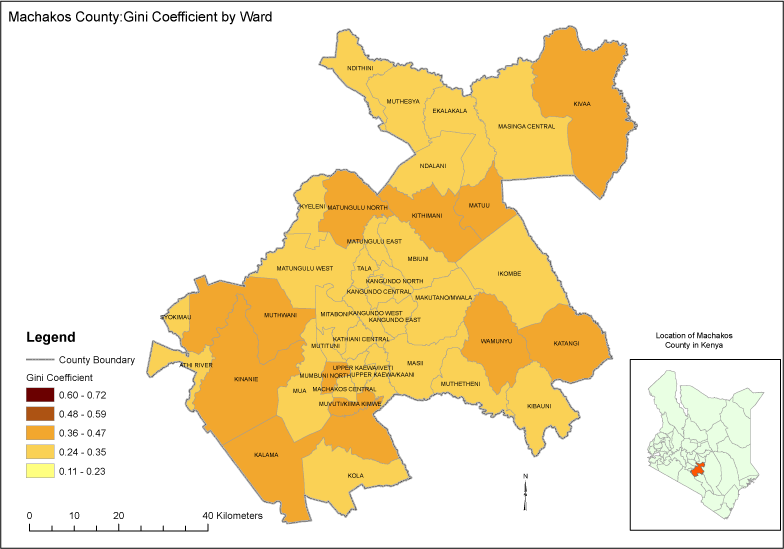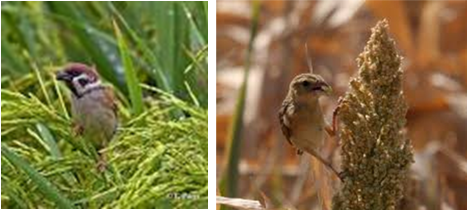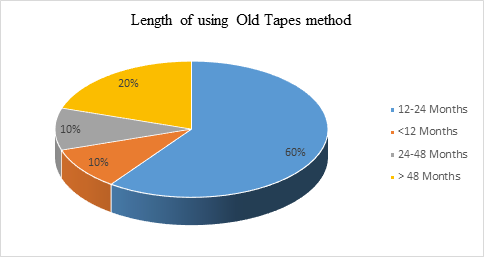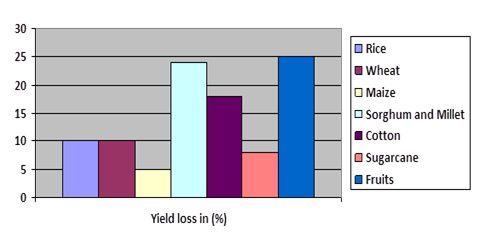Research Article
Volume 1 Issue 3 - 2017
The Use of Old Tapes as Scarecrows by Farmers to Protect Millet and Sorghum Against Birds in Machakos County in Eastern Kenya
School of Environmental Studies, Department of Community Development, Kenyatta University, Nairobi-Kenya
*Corresponding Author: Mutune JM, School of Environmental Studies, Department of Community Development, Kenyatta University, Nairobi-Kenya. E mail Id: Jmutune038@gmail.com
Received: August 05, 2017; Published: August 31, 2017
Abstract
Agriculture plays an integral part in the economic development our country. It accounts for about 82% of the GNI. This sector has employed over 75% of the citizens in different capacities. Regarding the same, women and children play the most vital role in ensuring food security at the household level. To enhance food security in the face of changing the climate, farmers have adopted new technologies to boost their crop yields. This purpose paper sought to investigate the use of old tapes in protecting white sorghum and millet against Quelea quelea bird species. The study adopted descriptive survey design, purposive sampling, structured interviews and case study reviews in gathering primary and secondary data. The study found out that 60% of the small scale farmers have adopted this innovation. Also, the study found out that the adoption of this innovation has led to an increase in crop yields, reduced workload and time spent scaring away birds in the farms. On the contrary, the short durability of the tapes, lack of government investment in innovative agriculture and lack of adequate field extension services were reported to be the main challenges. The study recommended an increase in field extensions services, more research and government investment in innovative technology agriculture to enhance food security.
Acronyms: CDs: Compact Disks; DVDs: Digital Visual Disks; GNI: Gross National Income; GDP: Gross Domestic Product; MDGs: Millennium
Development Goals; VCDs: Visual Compact Disks; US: United States;
Introduction
Agriculture is the back bone of the Kenyan economy. Agriculture accounts for 82% of the GNI and over 25% of the GDP. Also, more than 75% of the citizens are either self-employed farmers, casual farm workers or employed as skilled farm personnel. In 2005, agriculture accounted for 18% wage employment as well as 50% of the export revenue (UN data, 2017). According to World Bank (2015), a study conducted by “Feed The Future” in 2015 under the US Global hunger and food security initiative reported 5.6% GDP growth in Kenya. In this case, agriculture accounted for 32.9% of the added value. The first-millennium development goal (MDGs) also aims at eradicating extreme poverty and hunger ("Kenya: Vision 2030 Launched", 2007). This MDG can only be achieved if the country attains food security and self-sufficiency. The table below shows intervention measures to curb poverty by the year 2020.
| Parameter | Year | ||||
| 2000 | 2005 | 2010 | 2015 | 2020 | |
| Population (Million) | 30.2 | 33.4 | 36.5 | 39.7 | 43 |
| Poverty level (% ) | 56 | 60 | 26 | 10 | 0 |
| Poor people (Million) | 16.9 | 20.1 | 9.5 | 4.0 | 0 |
| Hungry people (Million) | 14.6 | 17.2 | 8.5 | 4.0 | 0 |
Source: Government of Kenya [GoK], (2009).
Table 1: Showing Government of Kenya targets on eradicating poverty by 2020.
Table 1: Showing Government of Kenya targets on eradicating poverty by 2020.
According to FAO (2011), Africa is the leading producer of maize, sorghum, pearl millet, finger millet, wheat, and rice. These grain crops are the staple food, and occupy 98.6 million hectares of the 252 million hectares of the arable land. Cereal crops amount to 162 million tonnes as shown in the table below.
| Crop | Area (ha) | Production (t) |
| Maize | 34, 075, 972 | 70, 076, 591 |
| Millet | 19, 998, 008 | 16, 008, 838 |
| Paddy rice | 11, 206, 813 | 28, 798, 202 |
| Sorghum | 23, 142, 595 | 23, 350, 064 |
| Wheat | 10, 224, 952 | 24, 704, 201 |
| Total | 98, 226, 080 | 162, 422, 507 |
Source: FAO, (2011).
Table 2: Showing area and population of selected cereal crops in Africa.
Table 2: Showing area and population of selected cereal crops in Africa.
On the other hand, studies show that crop yields in Sub-Saharan are likely to decline by more than 10% by the year 2055 (Gachene, Karuma & Baaru, 2015). Farmers therefore need to counter this anticipated yield decline by making their crop yields sustainable. In an effort to attain food security, the government of Kenyan has invested heavily in the agricultural sector in the past years. For instance, in 2015, 6.7% of the total budgetary allocation went to agriculture. However, this was below the 10% minimum allocation that was endorsed by the African Union in Maputo in 2002. In the financial year 2016/17, 4.3% of the total budget went to agriculture (Kinuthia & Lakin, 2017: CENTRE, 2017). It is evident that agriculture plays an integral part in the country’s economic development. However, despite the concerted efforts by the government, Kenya’s food security and self-sufficiency still remains threatened by unpredictable weather patterns and pest attacks such as: weevils, army worms, rodents and birds (“Kenya”, 2017).
This triggers the need to eliminate any draw backs such as bird pests. This is because controlling bird pests will help in curbing the decline in farm yields, which often results from pest infestation. In addition, an assessment of the progress of Kenya towards the implementation of the Zero Hunger by 2015 Regional Initiative needs to be conducted.According toTakamatsu (2017) pest birds in North America cause an annual rice yield loss of between 11-15%. Takamatsu further notes that common bird repellants such as sprays and chemicals only provide a short-term solution. In order to curb this problem, farmers from the North American region have devised bird guards. Bird guards are long–term cost effective electronic bird control units that target the specific species of birds that are causing crop loss in specific farms. Houinso & Mele (2009) adds that farmers in Thailand, Bangkok, Benin, Tanzania and India have effectively and efficiently used old cassette tapes to protect rice crop against bird pests. Houinso et al., (2009) points out that farmers in West Africa combine this method with other traditional techniques such as bird hunting nets, cloth scarecrows, use of slings and castanet method. Houinso & Mele (2011) concludes by stating that farmers in Mali have already shifted from using chemical and traditional pest control methods to using gift wrappings as scarecrows.
According to IITA Annual report and research highlights (1986), in a recent survey, rice scientists rated grain eating birds as the most damaging rice pests in West and Central Africa. This reports further states the use of flash tapes as the most recent innovation by farmers. Page 88 of this report notes that, in 1985, flash tapes were fitted in all IITA’s rice fields at the onset of flowering period. The flash tapes were tied on pole and suspended above the rice plants. The researchers noted that tapes were highly effective in scaring birds away during the first ten days. The scientists also observed that, birds such as Mannikins and weavers appeared nervous when perching near the tapes. In 1986, tapes were installed in selected rice fields, allowing birds a choice between the untaped and taped areas. It was observed that birds avoided the taped areas.
Similar experiments were carried out by Bida Agricultural Development Project (BADP) and the same results were obtained. It therefore appears that old cassette tapes can effectively protect sorghum and millet crops against birds’ damage. The protection will continue as long as birds have access to other food sources, other than the taped farms. The same technology can therefore be replicated in Kenya to protect white sorghum and millet against birds. This study sought to bridge the knowledge gap by investigate the effectiveness of using old cassette tapes in protecting white sorghum and millet against the quelea quelea bird species in Machakos County in Eastern Kenya. The research objectives for this study were to:
- Find out how old cassette tapes work.
- To investigate farmers’ preference for this method.
- To examine the challenges and benefits of this new innovation.
Study Methodology
This study was conducted between January and December 2016 in Machakos County of Eastern Kenya. The target population for this study was small-scale millet and sorghum farmers in Machakos County, who used old cassette tapes to protect sorghum and millet against bird pests. The study employed descriptive survey design in gathering both primary and secondary data. For this study, survey design was the most suitable compared to a mixed approach. This is because the researcher was only interested in farmers who used the old tapes as their sole bird control method. Both qualitative and quantitative data was collected during the study. The author employed simple random sampling in selecting 5 out the 8 Sub-counties for study. The 5 sub-counties comprised of: Yatta, Masinga, Kangundo, Matungulu and Mwala. The study employed purposive sampling in selecting 5 out of 11 divisions, and proportional stratified random sampling in selecting 3 survey locations from each of the 5 divisions. Purposive sampling was also used in selecting household heads as respondents of the study. Households were used as the unit of analysis. The sample size for this study was calculated using the formula derived by Fischer et al., [(1998) (Anon, 2017)].
Where:
n = the desired sample size (if the target population is greater than 10,000).
z = the standard normal deviate at the required confidence level which is 1.96 at 99% confidence level.
p = the proportion in the target population estimated to have characteristics being measured (households).
q = the level of statistical significance set.
n = the desired sample size (if the target population is greater than 10,000).
z = the standard normal deviate at the required confidence level which is 1.96 at 99% confidence level.
p = the proportion in the target population estimated to have characteristics being measured (households).
q = the level of statistical significance set.
From the available population of 264,500 households, 100 sorghum and millet farmers availed themselves for the interview. The farmers were then divided into two groups of 60 and 40 respectively. The first 60 respondents formed the study group. This group comprised of farmers who used old cassette tapes to protect only the white sorghum and millet varieties. The second group acted as a control group. This second group comprised of 40 farmers who used cassette tapes to protect other sorghum and millet varieties, other than the white variety. Structured questionnaires were then administered to the two groups.
Before administering the questionnaires, the researcher first sought the respondents’ consent and assured them of confidentiality. The researcher also subjected the tool to reliability and validity checks before use. The questionnaires contained the following survey questions: Which is the main farm pest for sorghum and millet? When do birds start coming into the farms? How do old cassette tapes work? Which other pest control methods have you been using before? Why do you prefer this method? How did you discover this method? For how long have you been using this method? What benefits do you get from using this method? What challenges do you encounter when using this method? A desktop review of similar case studies done in other parts of the world was used to enrich the findings and test the reliability of information got from the interviewee. Prior to analysis, the data collected was first examined for completeness.
Quantitative data was then cleaned, coded and fed into the Statistical Package for Social Sciences (SPSS) IBM version 20. Quantitative data was analyzed using simple descriptive statistics such as frequency distributions, totals, and percentages. Content analysis was used to analyse the qualitative data gathered; based on the emerging themes. The survey results were discussed in relation to the research objectives, and then presented in charts, graphs and tables.
Study Area
The study was conducted in Machakos County in Eastern Kenya. Machakos County stretches from latitudes 0045’ to 1031’ South and longitudes 36045’ to 370 45’ East.
Geographically Machakos County borders Embu County to the North, Murang’a and Kirinyaga Counties to the North West, Makueni County to the South, Kajiado Counnty to the South-west, Kitui County to the East, Nairobi and Kiambu counties to the West. The County is 6,208 square kilometers, and has a population of about 1,098,584 and 264,500 households, (KNBS, 2010). Although the area is semi-arid, there are significant seasonal and regional variations. The landscape is hilly, with an altitude range of 1000-1,600 meters above sea level. The high altitude areas include Kathiani, Kangundo, Matungulu, Mwala and Central Sub-Counties. The rest of the landscape is lowland-plains. The area has an average temperature of 19°C. The highest temperature is 25°C while the lowest temperature is 18°C. July is the coldest month while March and October are the hottest months. The area receives erratic and unpredictable bimodal rainfall. The long rains are received between March to May while the short rains start in October and end in December. The annual rainfall range is 500-1,300 millimeters (Huho, 2017).
The study area is dominated by the Kamba community; who belong to the Bantu speaking group. The inhabitants of Machakos practice mixed farming, and a few of them do business. According to the Kamba culture, men have full ownership and control rights over land. However, the duty of tilling and taking care of the land is vested on women and children. They, therefore, spend a better part of their day guarding the farms against grain eating birds. In the event of drought and famine, they are the most hit (Kenya, 2013). This is why women and their children have become innovative in guarding ‘their’ farms against Quelea.
Results and Discussions
The study targeted 120 households, but only 100 households were available hence formed the sample population. The response rate was 83.33% using the formula; (n/p) 100 where: n = the desired sample size and p = the proportion in the target population estimated to have characteristics being measured. This study found out that the Quelea quelea bird species was the main farm pest destroying sorghum and millet in Machakos County. This findings concur with the findings of Elliott (2008), who also found out that quelea is the worst grain eating bird species in Kenya. The first two images displays dark-beaked quelea quelea bird eating millet and sorghum respectively, while the last two images show a swarm of red-beaked quelea birds flying and resting on a tree twig.
Elliott (2008) further notes that the Quelea and Striga bird species are a major threat to pearl and finger millet, rice, and white sorghum. He adds that farmers to experience significant losses of cereals each year from these birds. This can be attributed to their movement in large flocks and heavy eating habit. This study found out that these birds invade the sorghum and millet farms towards the end of sorghum/millet growing season. 90% of the farmers interviewed confirmed February to March, and April to May as the sorghum/millet harvesting period.
During this study, the researcher asked farmers to explain how the old cassette tapes worked. Farmers stated that they looked for old cassette tapes and removed the tapes. They then tied the tapes either on trees around the farm or on the sorghum stalks. When wind blew, the tapes produced a whistling like sound that scared away. 80% of the farmers claimed that the birds got scared and flew away because they thought it is was a human being whistling. In addition to the sound, tapes also reflected light which scared away birds and rodents. 50% of the sorghum and millet farmers tied the tapes on sorghum/millet stalks while 30% of the farmers tied the tapes on the trees surrounding their farms. The remaining proportion (20%) of farmers combined the two methods. In addition to the different tape methods used, 30% of the farmers who had adopted this method combined tapes with gift wrappings, while 70% of the farmers used tapes only. The image below shows old tapes tied on a tree trunk around the farm.
This study was also interested in capturing other traditional or modern bird control methods used by sorghum and millet farmers. This study found out that farmers formerly used tree trunk-clothed scarecrows, pawpaw leaves-trumpets, hitting of metallic objects, and the manual way of scaring the birds away by use of stones and slings. During this study, the researcher also asked the respondents why they preferred this new method over other pest control methods. This study also found out that, despite this innovation being crude, 60% of the farmers in the study area preferred this method due to the following reasons:
First, the method is less expensive because it uses the re-use principle. Old tapes are locally available since their use has been bypassed by the new technology of flash disks, CDs, DVDs and live streaming. Parents usually task their children with the role of collecting these tapes whenever they come across them. Secondly, tying tapes around trees or sorghum plants does not require any special skill. Thirdly, most farmers prefer to use of tapes as opposed to using insecticides because it has no health effects. The use of insecticides has many health effects on people and livestock. For instance, if children roast and eat the poisoned birds, they may easily die. The same harm also happened to livestock who were fed on the sprayed crop stalks or accidentally graze on the sprayed crops. The use of old cassette tapes as scarecrows has therefore proven to be both ecofriendly and health friendly.
Fourth, cassette tapes cover vast areas compared to cloth-scarecrows which only serve a small circumference. Fifth, the sound produced by tapes not only scares away birds but also other pests such as rodents. Finally, the thinness of old cassette tapes makes them stay in motion even when less wind blowing. This means that they can serve as scarecrows in both day and night. The thinness also ensures that birds neither patch nor fly near them. This findings support the IITA Annual report and research highlights (1986) and the works of Bida Agricultural Development Project. During the study the author found out that 90% of the respondents had been using this new method for more than a year as shown in the pie chart below.
In regard to the benefits accrued by farmers after using this method, 100% of the farmers reported a 70% increase in sorghum and millet yields. Also, there was no significant increase in yields between the two groups of farmers. The table below shows the estimate crop loss caused by bird pests before adopting this new technology.
| Crop | Estimated loss in the fields due to Pests (%) | Possible production in absence of pests (mt) | Estimated loss in million USD |
| Maize | 3.2 | 12.7 | 215 |
| Sorghum and Millet | 8.5 | 25.4 | 580 |
| Seed cotton | 2.7 | 10.8 | 675 |
| Totals | 14.4 | 48.9 | 1470 |
Table 3: Estimated crop loss caused by pests under modern agriculture.
The bar graph below shows losses in field crops due to bird infestation
In addition, sorghum and millet farmers reported a reduction in workload and saving of saving time and energy. This is because they do not have to be physically present in the farms to scare away the birds, as they used do to before. 80% of the respondents stated that their children spend more time on studies as opposed to the past. Formerly, children had to leave school and help their mothers guard the farms against bird pests.
Finally, farmers who have embraced this new method reported the following challenges: first, tapes were not long lasting. One farmer said,” tapes break easily when exposed to direct sun for a long period.” The use of old cassette tapes is thus limited to only one season. Secondly, old tapes were gradually becoming rare because they were outdated. Their diminishing supply thus threatened the future of this innovation. Thirdly, from the existing literature, the author found out that the government had been investing heavily on fertilizers, provision of seed and marketing. 60% of the farmers also reported lack of field extension services. The absence of this vital agricultural services was blamed on the corrupt nature of the agricultural officers. Farmers had to pay between $5 and $10 to get these services. Finally, all the respondents attested that they lacked ownership rights for their innovation. Therefore, farmers are at risk of losing their innovation to other people.
Recommendations
Culture has socialized women as farm tillers. During the study, women who were interviewed referred to themselves as innovative. Also, women easily adopt new technologies and ideas compared to men (Richard, Onyango, Mbuvi & Kironchi, 2012). They, therefore, have enormous potential for enhancing food security. If their attitude and virtues are effectively utilized, the country will achieve food security with ease. Agricultural extension officers therefore need to uphold their integrity, increase their contact with female farmers and educate farmers on other pest control methods that are eco-friendly and long lasting.
Culture has socialized women as farm tillers. During the study, women who were interviewed referred to themselves as innovative. Also, women easily adopt new technologies and ideas compared to men (Richard, Onyango, Mbuvi & Kironchi, 2012). They, therefore, have enormous potential for enhancing food security. If their attitude and virtues are effectively utilized, the country will achieve food security with ease. Agricultural extension officers therefore need to uphold their integrity, increase their contact with female farmers and educate farmers on other pest control methods that are eco-friendly and long lasting.
Although the study found out that the government had been investing heavily in agriculture over the past five years, pest control had received minimal attention. There is need to shift emphasis to this new technology. For instance, more studies need to be carried out with an aim of improving and documenting this new technology. Moreover, there is need to protect this innovation by establishing a copyright.
In conclusion, embracing innovative technology in agriculture has proven to be a suitable solution to food insecurity. The government should invest heavily on this new innovation in order to elevate the food security status.
References
- Anon. (2017):
- CENTRE T. “Consolidating Gains for a Prosperous Kenya”. Kenya Budget Statement 2016/17 tralac(2017):
- ELLIOTT C. “The migrations of the Red-billed Quelea Quelea quelea and their relation to crop damage”. Ibis 132.2 (2008): 232-237.
- FAO. “The state of food and agriculture. Women in Agriculture”. Closing the Gender gap for Development (2011):
- Gachene CKK., et al. “Climate Change and Crop Yield in Sub-Saharan Africa”.
- Government of Kenya. “10 years of fight against poverty (1999-2009). A report of the poverty eradication commission”. (2009):
- Houinso F and Mele P. “Protect your rice crop against birds”. Barza Scripts (2011):
- Houinsou F and Mele P. “Combine different methods to keep birds away from rice fields”. Tanzania (2009):
- Huho J. “An Analysis of Rainfall Characteristics in Machakos County, Kenya”. IOSR Journal Of Environmental Science, Toxicology And Food Technology 11.4 (2017): 64-72.
- “IITA Annual report and research highlights”. (1986): 88.
- Kenya National Bureau of Statistics. “The 2009 Kenya population and housing census. Nairobi: Kenya”. (2010):
- Kenya. “Machakos County development profile”. (2013):
- Kenya. “Feed the Future”. (2017):
- “Kenya: Vision 2030 Launched”. Africa Research Bulletin: Economic, Financial And Technical Series 44.5 (2007): 17404B-17404C.
- Kinuthia J and Lakin J. “Kenya: Analysis of the 2016/17 National Budget Estimates”. National budget estimates (2017):
- Rao MR and Mathuva MN. “Legumes for improving maize yields and income in semi-arid Kenya”. Agriculture, Ecosystems and Environment 78.2 (2000): 123-137.
- Richard KTK., et al. “Climate Change and Variability: Farmers' Perception, Experience and Adaptation Strategies in Makueni County, Kenya”. Asian Journal of Agriculture and Rural Development 2.3 (2012): 2224-4433.
- Takamatsu M. “Protect Rice from Birds”. (2017):
- "UN data country profile Kenya”. (2017):
Citation:
Mutune JM. “The Use of Old Tapes as Scarecrows by Farmers to Protect Millet and Sorghum Against Birds in Machakos
County in Eastern Kenya”. Innovative Techniques in Agriculture 1.3 (2017): 152-160.
Copyright: © 2017 Mutune JM. This is an open-access article distributed under the terms of the Creative Commons Attribution License, which permits unrestricted use, distribution, and reproduction in any medium, provided the original author and source are credited.




































 Scientia Ricerca is licensed and content of this site is available under a Creative Commons Attribution 4.0 International License.
Scientia Ricerca is licensed and content of this site is available under a Creative Commons Attribution 4.0 International License.